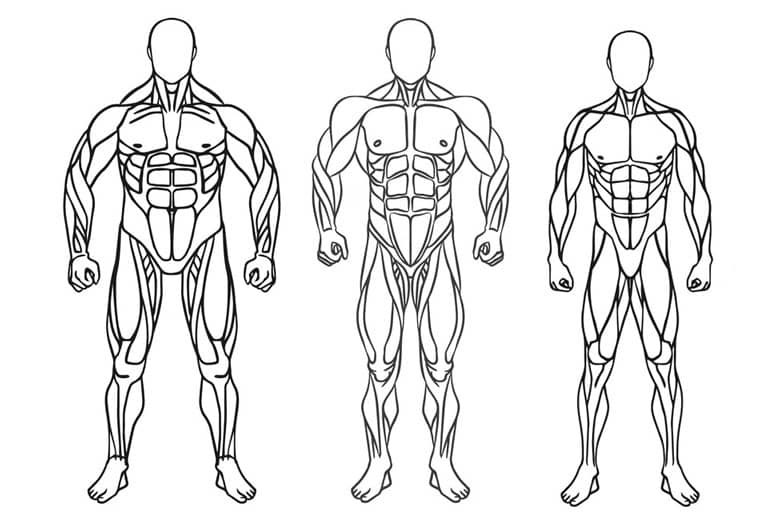A mesomorph is someone with a medium build and naturally athletic physique, characterized by broad shoulders, a muscular chest, and well-defined arms and legs. Mesomorphs typically have a lower body fat percentage, are not usually taller than average, and can easily gain muscle mass.
Mesomorphs are one of the three primary somatotypes, along with ectomorphs (who are leaner and more slender) and endomorphs (who have a larger frame and a curvier build). Understanding your body type can help you fine-tune your training and nutrition to address areas like strength, cardiovascular endurance, or flexibility.
Research suggests that tailoring workouts to body types may lead to improved health outcomes. For example, mesomorphs often excel in strength- and power-based activities like rowing, swimming, weightlifting, and combat sports, while ectomorphs may thrive in disciplines like high jumping or cycling.
Strength Training for Mesomorphs
Mesomorphs naturally possess more muscle mass than other body types, making strength training especially effective for them. Regular resistance workouts help maintain or increase muscle mass, support metabolic function, and promote a well-defined, muscular appearance. A typical strength training program for mesomorphs includes three to four sessions per week. Each exercise should be performed for three to six sets with six to twelve repetitions, which is optimal for hypertrophy and strength development.
Compound movements such as squats, deadlifts, bench presses, and pull-ups should form the foundation of the routine, as they engage multiple muscle groups simultaneously. These can be supplemented with isolation exercises like bicep curls, tricep extensions, and leg curls to target specific muscles. Moderate to heavy weights should be used, with rest periods between sets kept short—around 60 to 90 seconds—to maintain intensity and promote muscle growth.
Cardio Training for Mesomorphs
Cardiovascular training is essential for mesomorphs to maintain heart health, preserve lean muscle, and prevent fat gain. According to fitness guidelines, mesomorphs should aim for 150 to 300 minutes of moderate-intensity aerobic activity each week. The choice of cardio—whether walking, cycling, swimming, or running—depends on personal preference and what can be done consistently.
Balancing cardio with strength training requires some experimentation. If cardio is done before lifting, it might reduce energy for resistance exercises. In such cases, reversing the order or separating the sessions may lead to better results. The key is to integrate cardio without compromising the effectiveness of strength training.
HIIT Training for Mesomorphs
High-intensity interval training (HIIT) is particularly beneficial for mesomorphs due to their athletic build and fast muscle response. HIIT involves short bursts of high-intensity aerobic exercises followed by brief rest periods. These workouts typically last 15 to 20 minutes and can include activities like sprinting, cycling, rowing, stair climbing, or bodyweight exercises such as jumping jacks, lunges, and burpees.
Each burst of intense activity lasts around 20 to 30 seconds, followed by 30 to 60 seconds of rest. This style of training is excellent for building fast-twitch muscle fibers, boosting cardiovascular health, and improving overall fitness in a time-efficient way.
Flexibility and Stretching for Mesomorphs
Flexibility training is essential for mesomorphs to maintain mobility, prevent injury, and enhance workout performance. According to experts, mesomorphs commonly experience tightness in areas like the hips, iliotibial (IT) bands, chest, and glutes. To address this, dynamic stretching is recommended before workouts to prepare the body. These active stretches — such as torso twists, leg swings, and walking lunges — increase heart rate, engage muscles, and mimic workout movements, reducing the risk of injury.
Dynamic stretches can also be included in the cooldown phase to gradually bring the body back to rest. Static stretching, on the other hand, is best performed post-workout. This type of stretching involves holding positions like hamstring, triceps, and calf stretches to gently elongate muscles without strain. Additionally, incorporating practices like yoga and Pilates can be highly beneficial for mesomorphs. These activities not only enhance flexibility but also support mental wellness and recovery. For those resistant to traditional stretching, yoga serves as an effective alternative to improve flexibility in a structured and calming way.
Nutrition for Mesomorphs: What to Eat
Nutrition plays a critical role in achieving fitness goals, regardless of body type. For mesomorphs aiming to build muscle or reduce body fat, tracking progress through periodic body fat measurements is helpful. Caloric intake should align with individual goals and activity levels. For muscle gain, a calorie surplus is necessary to support muscle growth and workout demands.
Protein is vital for muscle repair and growth. Active individuals, especially athletes, may need between 1.2 to 2 grams of protein per kilogram of body weight daily. A practical starting point is consuming 30 grams of protein per meal. Complex carbohydrates are equally important as they provide energy, support digestion, and boost immune function. Opting for whole food sources ensures better nutrient absorption and sustained energy levels.
Healthy fats also contribute significantly to overall health. They supply energy during rest and prolonged exercise, while supporting brain function, mental well-being, and joint health. To achieve optimal results, it’s beneficial for mesomorphs to work with a certified trainer or registered dietitian who can tailor a balanced diet that aligns with their specific fitness and body composition goals.
Mesomorph Myths and Mistakes to Avoid
Despite their naturally athletic build, mesomorphs often face misconceptions about health and fitness. One common myth is that they must follow a specific diet, avoiding certain foods altogether. However, the key to long-term success is a sustainable eating plan rather than rigid rules or restrictions. Another mistaken belief is that mesomorphs don’t need to exercise. While they may appear fit, neglecting physical activity can lead to health issues beneath the surface.
There’s also a false assumption that mesomorphs can eat anything without negative consequences. In reality, like any other body type, they can gain fat and suffer from poor health habits. Additionally, looking fit doesn’t necessarily mean a mesomorph enjoys exercise or possesses a superior work ethic. Motivation and consistency are still crucial, and support is often needed. A major pitfall among mesomorphs is overtraining — many skip rest days and sacrifice sleep, which can hinder recovery and progress.
Takeaway
Knowing your body type, such as being a mesomorph, can help you design effective workout and nutrition plans. However, personal preferences, lifestyle, and goals should always take priority. A balanced routine — combining strength training three to four times a week, regular cardio, and flexibility practices like dynamic stretching — supports muscle development and helps prevent injuries.
Nutrition is equally important. Mesomorphs benefit from adequate protein intake for muscle repair, complex carbohydrates for energy and digestion, and healthy fats for endurance and overall well-being. Partnering with a trainer or dietitian can ensure your nutrition aligns with your goals. Ultimately, while body type provides useful insights, the most effective plan is one that respects your body’s signals and adapts to your individual needs over time.
Disclaimer:
The information contained in this article is for educational and informational purposes only and is not intended as a health advice. We would ask you to consult a qualified professional or medical expert to gain additional knowledge before you choose to consume any product or perform any exercise.







